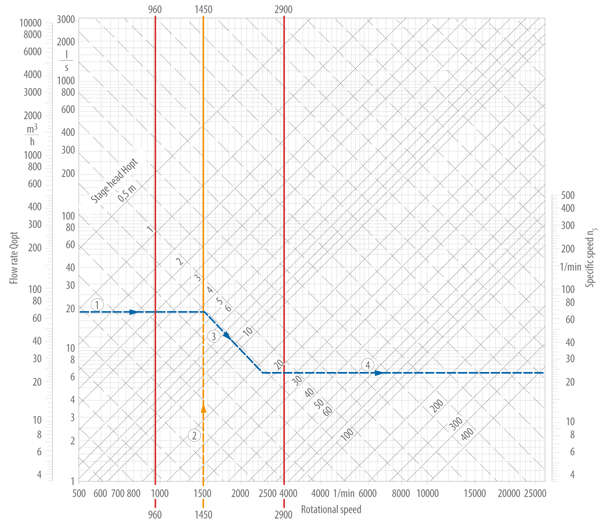Specific speed
The specific speed (ns) is a characteristic coefficient derived from the similarity conditions which allows a comparison of impellers of various pump sizes even when their operating data differ (flow rate and head at best efficiency point, rotational speed). The specific speed can be used to classify the optimum impeller design and the corresponding pump characteristic curves.
See Fig. 1 Specific speed

Fig. 1 Specific speed: Influence of specific speed ns on centrifugal pump impeller design; the diffuser elements (casings) of single-stage pumps are outlined (blue).
Defined as the theoretical rotational speed at which a geometrically similar impeller would run if it were of such a size as to produce 1 m of head (Hopt) at a flow rate (Qopt m3/s at the best efficiency point, the specific speed is expressed in the same units as the rotational speed:

Qopt in m3/s Flow rate at ηmax
Hopt in m Head at ηmax
n in rpm Pump speed
ns in rpm Specific speed
Hopt in m Head at ηmax
n in rpm Pump speed
ns in rpm Specific speed
A dimensionless characteristic coefficient in accordance with DIN 24260 can be established using the following equation:

ns* in rpm-1 Rotational speed
Qopt in m3/s Flow rate at ηmax
Hopt in m Head at ηmax
g = 9.81 m/s2 Acceleration due to gravity
Qopt in m3/s Flow rate at ηmax
Hopt in m Head at ηmax
g = 9.81 m/s2 Acceleration due to gravity
The following relationship exists between the numerical values of the dimensional and dimensionless coefficients:

The values to be inserted in the above equation are the optimum head Hopt for one stage in the case of multistage pumps, and the optimum flow rate Qopt for one impeller half in the case of double-entry impellers.
The fluid flow through the impeller changes with increasing specific speed, i.e. radial impellers have low specific speeds, mixed flow ("diagonal") impellers have a higher specific speed range and axial impellers have the highest specific speeds. Establishing the specific speed ns via a graph:
See Annex, Specific speed, Fig 2
See Annex, Specific speed, Fig 2

Fig. 2 Specific speed: Establishing the specific speed ns via a graph
Diffuser elements on radial casings such as volute casings are also required to become larger and larger with increasing specific speed as long as the flow can be guided through the impeller in a radial direction. Eventually (i.e. at high specific speeds) the flow can only exit axially, e.g. via tubular casings.
The specific speed's numerical value is also needed to select the influencing factors required for the conversion of pump characteristic curves, for example, if fluids of higher viscosity or solids-laden fluids are pumped).
In Anglo-Saxon countries the specific speed is called "type number K" in accordance with DIN EN ISO 17769-1 and DIN EN ISO 9906. In the USA it is referred to as Ns (pump specific speed), with the flow rate being specified in gallons/min, the head in foot and the rotational speed in rpm. The conversion factors are:
K = ns / 52.9 and Ns = ns ∙ 51.6
